How to see a black hole?
The image of a black hole obtained last week through the efforts of eight telescopes and thirteen institutes was blurred and less interesting than the drawings of artists, so the historical event gave rise to many sometimes malicious snitches (if you did not see it: donut , eye of Sauron , cat , cats , marketing ). How can we see black holes in good quality while realistically?
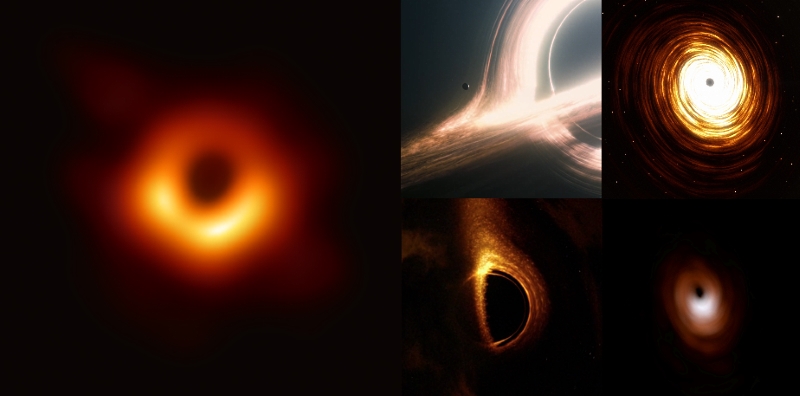
Last week showed that the image of a black hole can be obtained by combining several telescopes in different parts of the globe into an interferometer with an extra-long base and spending a large amount of machine and human time on processing the obtained data.
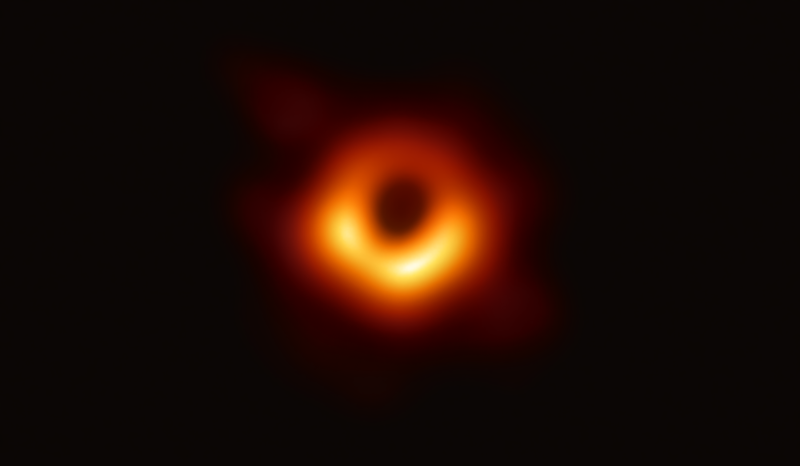
Image of Event Horizon Telescope Collaboration
The greater the distance between telescopes combined into an interferometer, the higher the resolution. 20 angular microseconds Event Horizon Telescope compared with reading a newspaper in New York from Paris. The supermassive black hole in the M87 galaxy has a diameter of 40 billion kilometers, its shadow, visible as a black hole in the center, is 2.5 times larger (100 billion), and the accretion disk of the absorbed gas rotates around several times wider. Therefore, a black hole could be seen from a gigantic distance of 55 million light years.
Despite the fact that a black hole absorbs everything that has flown beyond the horizon of events, it can be noticed by studying the behavior of matter outside this horizon. Observing the motion of stars for decades, you can see how in the center of our galaxy they revolve around some kind of heavy, but invisible object.

Image Keck / UCLA The
accretion disk of a black hole generates relativistic jets (jets) - plasma flows emitted at almost light speed. For example, the combination of images in the visible (“Hubble”) and radio range of the Hercules A galaxy jet.

NASA image
A jet emanating from the center of the Centaurus A galaxy is larger than the galaxy itself.
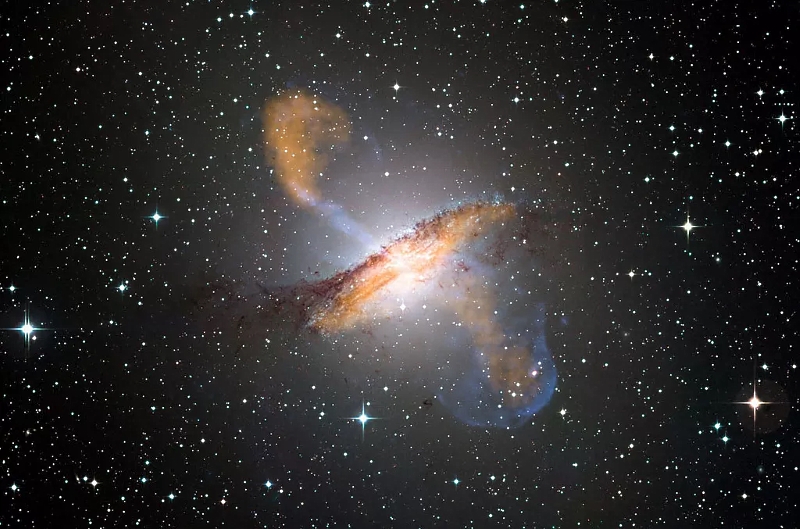
CXC / NASA and ESO image
Emissions may be of another form. Here are two “sneezes” of a supposedly black hole 26 million light-years away from us in the x-ray range.

NASA image
Another option is to look at the change in the trajectory of light passing near a black hole. Due to the curvature of space, its path changes, and the effect of gravitational lensing arises, thanks to which we see the same object repeated in the sky several times. It turns out especially clearly when the galaxy lenses a quasar (supermassive black hole) - an “Einstein cross” appears in the sky.
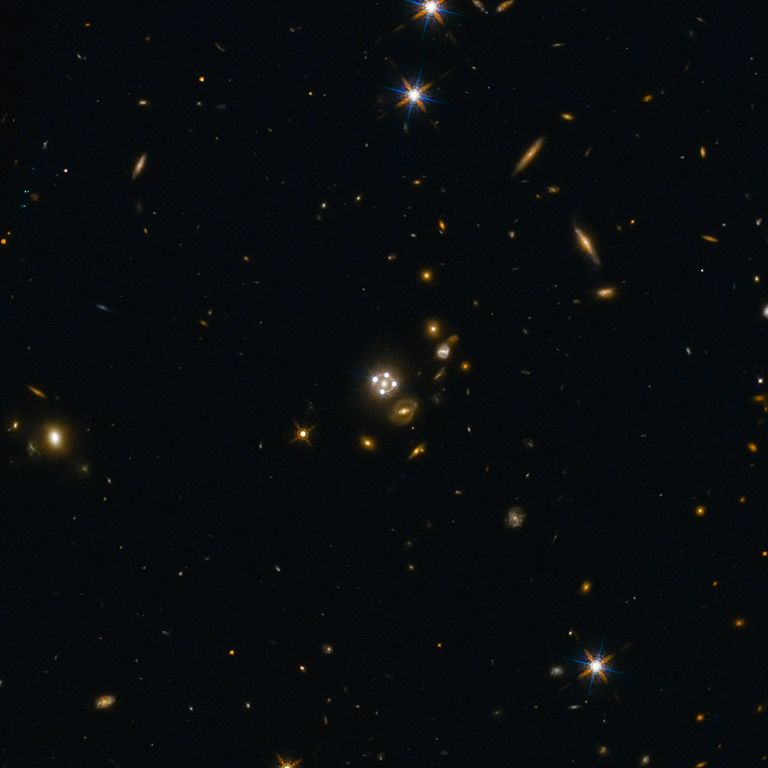
The
2016 NASA image gave us the opportunity to also hear black holes. Converted into a range audible to the human ear, gravitational waves from the confluence of two black holes complement the visual beauty above.
Where reality fails, cinema comes to the rescue. Fortunately for us, the directors are not too lazy to invite real scientists as scientific consultants, and the drawn objects are very realistic. Released in 2014, Interstellar boasted a very high-quality image of a supermassive black hole created on the basis of equations written by physicist Kip Thorne.

Movie frame
And the creators of the picture “High Society” that appeared last year attracted the French astrophysicist Aurelien Barrot. The result was much closer to the Event Horizon Telescope image than Interstellar’s.

Movie frame
There is no point in arguing which of the scientists is more right - both images show scientifically correct phenomena of gravitational lensing and accretion disk. By the way, the first image of a black hole was created back in 1979 by the French astrophysicist Jean-Pierre Lumine using a computer and, which is not surprising, it looks like both above and the photo of a real black hole received last week.

And if it’s not enough for someone to just watch and want more interactivity, for example, to fly around a black hole on their own, then the Space Engine free planetarium-sandbox is best for this. To be near the black hole in the center of the M87 there is a matter of a couple of minutes. We find the galaxy, press Ctrl + Shift + G, voila, we are there.

We take a screenshot, play a little with brightness and color, and we have an almost exact copy of the real image.
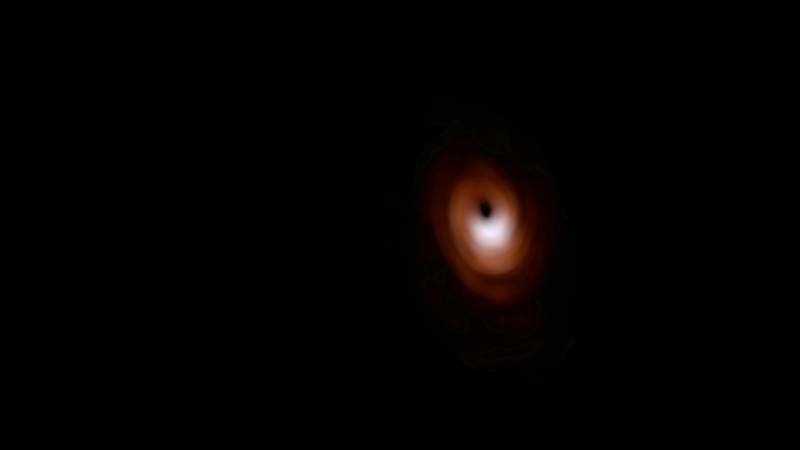
And since the Space Engine can virtually fly around the universe, enthusiasts not only looked at the M87, but also found much more beautiful shots.

Black hole in the center of M87
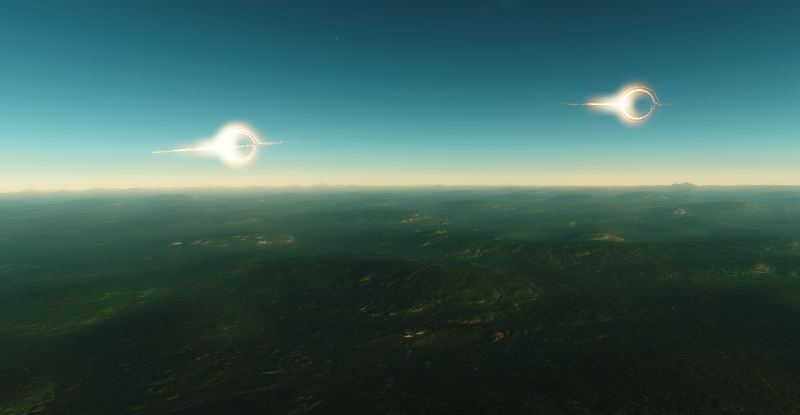




Reality
Last week showed that the image of a black hole can be obtained by combining several telescopes in different parts of the globe into an interferometer with an extra-long base and spending a large amount of machine and human time on processing the obtained data.

Image of Event Horizon Telescope Collaboration
The greater the distance between telescopes combined into an interferometer, the higher the resolution. 20 angular microseconds Event Horizon Telescope compared with reading a newspaper in New York from Paris. The supermassive black hole in the M87 galaxy has a diameter of 40 billion kilometers, its shadow, visible as a black hole in the center, is 2.5 times larger (100 billion), and the accretion disk of the absorbed gas rotates around several times wider. Therefore, a black hole could be seen from a gigantic distance of 55 million light years.
Despite the fact that a black hole absorbs everything that has flown beyond the horizon of events, it can be noticed by studying the behavior of matter outside this horizon. Observing the motion of stars for decades, you can see how in the center of our galaxy they revolve around some kind of heavy, but invisible object.

Image Keck / UCLA The
accretion disk of a black hole generates relativistic jets (jets) - plasma flows emitted at almost light speed. For example, the combination of images in the visible (“Hubble”) and radio range of the Hercules A galaxy jet.

NASA image
A jet emanating from the center of the Centaurus A galaxy is larger than the galaxy itself.

CXC / NASA and ESO image
Emissions may be of another form. Here are two “sneezes” of a supposedly black hole 26 million light-years away from us in the x-ray range.

NASA image
Another option is to look at the change in the trajectory of light passing near a black hole. Due to the curvature of space, its path changes, and the effect of gravitational lensing arises, thanks to which we see the same object repeated in the sky several times. It turns out especially clearly when the galaxy lenses a quasar (supermassive black hole) - an “Einstein cross” appears in the sky.

The
2016 NASA image gave us the opportunity to also hear black holes. Converted into a range audible to the human ear, gravitational waves from the confluence of two black holes complement the visual beauty above.
Movie
Where reality fails, cinema comes to the rescue. Fortunately for us, the directors are not too lazy to invite real scientists as scientific consultants, and the drawn objects are very realistic. Released in 2014, Interstellar boasted a very high-quality image of a supermassive black hole created on the basis of equations written by physicist Kip Thorne.

Movie frame
And the creators of the picture “High Society” that appeared last year attracted the French astrophysicist Aurelien Barrot. The result was much closer to the Event Horizon Telescope image than Interstellar’s.

Movie frame
There is no point in arguing which of the scientists is more right - both images show scientifically correct phenomena of gravitational lensing and accretion disk. By the way, the first image of a black hole was created back in 1979 by the French astrophysicist Jean-Pierre Lumine using a computer and, which is not surprising, it looks like both above and the photo of a real black hole received last week.

Virtuality
And if it’s not enough for someone to just watch and want more interactivity, for example, to fly around a black hole on their own, then the Space Engine free planetarium-sandbox is best for this. To be near the black hole in the center of the M87 there is a matter of a couple of minutes. We find the galaxy, press Ctrl + Shift + G, voila, we are there.

We take a screenshot, play a little with brightness and color, and we have an almost exact copy of the real image.

And since the Space Engine can virtually fly around the universe, enthusiasts not only looked at the M87, but also found much more beautiful shots.

Black hole in the center of M87




